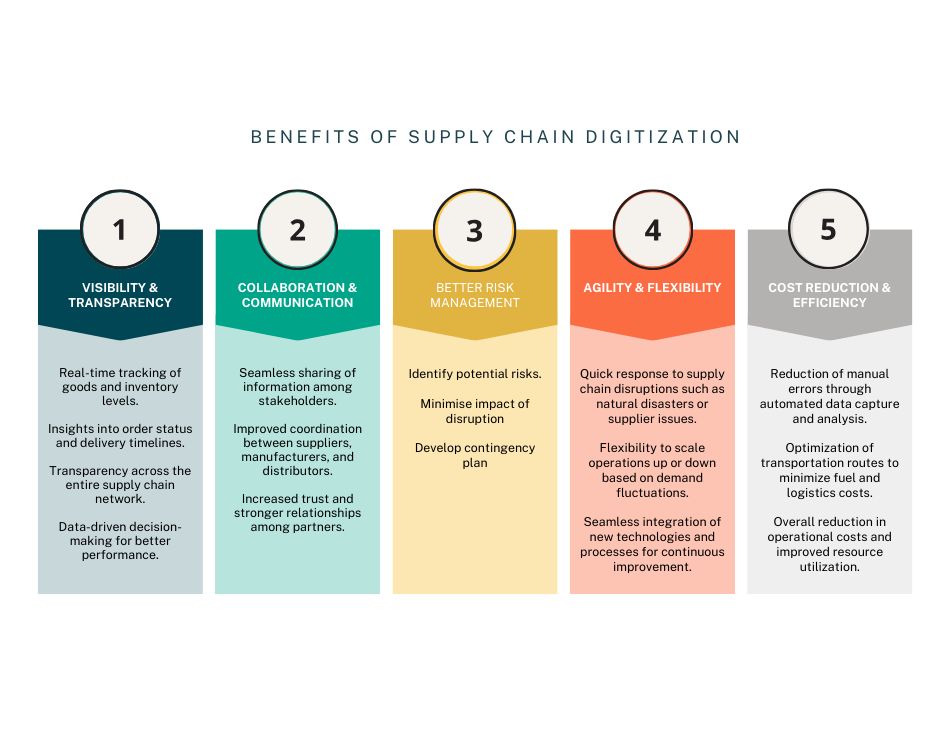Navigating the Digital Supply Chain: Mitigating Risks in an Interconnected World
In today’s rapidly evolving digital landscape, the concept of supply chain has transcended the realm of physical goods. The digital supply chain, an intricate web of interconnected technologies, data flows, and collaborations, has become the backbone of modern business operations. However, with this digitization comes a new breed of risks – digital supply chain risks – that demand our attention and proactive measures.
This article delves into the complexities of digital supply chain risk management, underscoring its significance and offering insights to safeguard your organization’s interconnected ecosystem.

The Digital Supply Chain Ecosystem
Traditionally, the supply chain encompassed the flow of tangible products from raw materials to the end consumer. Today, it extends to encompass a virtual labyrinth of software, networks, vendors, partners, and data streams. This interconnected ecosystem enhances efficiency but introduces vulnerabilities that, if exploited, can disrupt operations, compromise data, and tarnish reputation.
Gartner’s designation of digital supply chain risk as a top security concern speaks volumes about its potential impact. A staggering prediction reveals that nearly half of all organizations will experience digital supply chain attacks by 2025. Real-world data echoes this concern, exemplified by Marsh’s findings of supply chain compromises affecting millions.
Building Resilience: Preparing for the Unforeseen
Resilience becomes paramount in mitigating digital supply chain risk. Organizations must plan for disruptions, both in their own operations and those of their vendors. Business continuity and disaster recovery strategies prove invaluable in maintaining operations during turbulent times.
Understanding Digital Supply Chain Risks:
- Third-Party Vulnerabilities: Relying on external vendors and partners introduces the risk of their security shortcomings becoming your own. A breach in a vendor’s system can reverberate across the supply chain, potentially affecting your organization.
- Data Breaches and Privacy Concerns: As data flows through the digital supply chain, it becomes susceptible to breaches. Sensitive information, if compromised, can lead to regulatory violations, legal consequences, and erosion of trust.
- Supply Chain Interruptions: Cyberattacks, natural disasters, or operational failures in any part of the digital supply chain can disrupt services, delay deliveries, and impact customer satisfaction.
- Counterfeit and Tampering: The digital supply chain can provide opportunities for counterfeit products or unauthorized alterations to infiltrate the ecosystem, leading to financial losses and reputational damage.
Mitigating Digital Supply Chain Risks:
- Comprehensive Vendor Assessments: Thoroughly vet and continuously monitor vendors and partners for their cybersecurity posture and compliance with industry standards.
- Data Protection and Encryption: Encrypt sensitive data as it traverses the digital supply chain to prevent unauthorized access and maintain data integrity.
- Multi-Layered Security: Implement a multi-faceted security strategy that includes firewalls, intrusion detection systems, and real-time monitoring to detect and respond to threats promptly.
- Incident Response Planning: Develop and regularly test an incident response plan to minimize the impact of disruptions and swiftly restore normal operations.
- Employee Training: Educate employees about digital supply chain risks, their role in cybersecurity, and the importance of adhering to best practices.
The Digital Transformation Revolution: A New Realm of Possibilities and Risks
The shift toward digital transformation has revolutionized the concept of supply chains, extending beyond tangible goods to encompass a complex network of digital technologies and data flows. The global supply chain market’s exponential growth is a testament to this paradigm shift, underlining the pivotal role digital supply chains play in modern business.
From Disruption to Dependence: The Birth of Digital Supply Chain Risks
With the rise of what McKinsey termed “Supply Chain 4.0,” the integration of digital technologies like IoT, cloud, blockchain, and AI has redefined the supply chain landscape. This evolution has led to an interconnected ecosystem, enabling digital transformation, operational excellence, and customer satisfaction. However, with dependency comes vulnerability, as the digital supply chain becomes a prime target for cyberattacks.
Benefits of Digital Supply chain
In today’s rapidly evolving business landscape, digitalization has emerged as a transformative force, revolutionizing the way organizations manage their supply chains. By leveraging advanced technologies and data-driven insights, businesses can unlock a myriad of benefits that enhance efficiency, resilience, and competitiveness across the supply chain ecosystem.

The Ripple Effect: Shared Responsibility in the Digital Supply Chain
The pivotal lesson from real-world cases like Okta’s breach is that organizations can no longer rely solely on their cybersecurity defenses. A vendor’s cybersecurity posture becomes a crucial link in the chain, underscoring the need for holistic risk management across the digital ecosystem.
Holistic Risk Management: A New Imperative
Traditional risk management strategies fall short in tackling the complexities of the digital supply chain. Embracing risk intelligence offers a holistic perspective, empowering organizations to identify potential risks and vulnerabilities across the entire supply chain.
Building Resilience: Preparing for the Unforeseen
Resilience becomes paramount in mitigating digital supply chain risk. Organizations must plan for disruptions, both in their own operations and those of their vendors. Business continuity and disaster recovery strategies prove invaluable in maintaining operations during turbulent times.
Conclusion:
The digital supply chain is the conduit through which innovation, efficiency, and collaboration flow. Yet, it is not immune to the perils of our interconnected world. Navigating these risks requires a proactive approach that encompasses vigilance, collaboration, and ongoing adaptation. By understanding the nuances of digital supply chain risks and implementing a comprehensive risk management strategy, organizations can strengthen their resilience and continue reaping the rewards of a digitized supply chain while safeguarding their most valuable assets.
Let’s collaborate in navigating the complexities of the digital supply chain and creating a more secure business landscape together.
In the age of digital transformation, the mastery of digital supply chain risk management is an imperative that distinguishes the resilient from the vulnerable. Let’s embark on this journey together and secure the future of our interconnected business landscape.


